A.R. Jung's Blog
June 13, 2022
Mythical Creature, ‘the Adhene Fairy,’ which is a child-sized being from The Isle of Man-with writing prompt
 Photo credit: bing images
Photo credit: bing imagesThese fairies are from The Isle of Man, (‘Manx.’) Which is a self-governing body under British rule.
It sits in the Irish Sea between the islands of Great Britain and Ireland. According to Wikipedia, these Manx fairies are called Adhene and are known as ‘Cloan ny moyrn,’ (which means the Children of Pride or Ambition.)
The site, Fantasy-bestiary says that according to Manx folklore, these fairies are fallen angels that were exiled from heaven along with Satan. They were cast from heaven, but are too good for hell.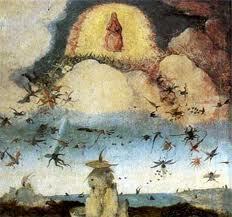 When they fell…they rained down from heaven in a thick shower that lasted for three days and three nights.
When they fell…they rained down from heaven in a thick shower that lasted for three days and three nights.
In present day they live on the earth, in the air, and in the sea, and that is where they will continue to live until the Judgement.
They are not small like English fairies. They are shy, and most of them are female. About the size of a small child, when visible they are fishing at sea or herding cattle on the hills.
You can see them playing in waterfalls or dancing on the tops of mountains. The Manx people always know when it will be a good fishing season or a great harvest because they will hear the fairies making storage barrels in the caves.
They are beautiful, and mischievous, and mostly harmless.
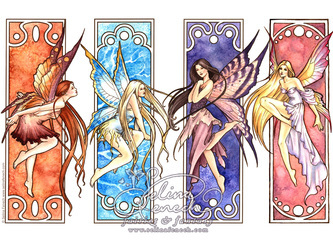 https://about-mythical-creatures.weebly.com/fairies.html
https://about-mythical-creatures.weebly.com/fairies.htmlThere are some of course who are more sinister than others.
These malevolent fairies live apart from the others in caverns, under heavy fog, or in other dark places. They have been known to kidnap babies or take the wives of unsuspecting men… whenever they felt compelled to do so. These fairies delight in causing misery, but it is believed that they cannot harm a person on an errand of mercy. It is unclear, however, who it is that they continue to answer to, and why they are not allowed to interfere with a person on an errand of benevolence. That is for you to decide.
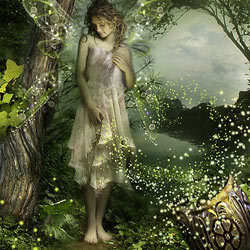 https://about-mythical-creatures.weebly.com/fairies.html
https://about-mythical-creatures.weebly.com/fairies.htmlIf you should find yourself walking at night on the Isle of Man and you don’t happen to be on an errand of mercy, the old legend recommends that you chant this prayer,
“Saue Jee mee voish Cloan ny moyrn.” (God save me from the children of the pride.)
Writing prompt
 https://gold-n-blog.fr/critiques-de-films/chroniques-de-spiderwick/
https://gold-n-blog.fr/critiques-de-films/chroniques-de-spiderwick/You would go on vacation if you only had the time.
You are a very busy doctor who loves all things big and small. What kind of doctor you ask? You are a cryptid doctor, within the field of Cryptozoology. You believe in the existence of entities from the folklore record, as well as animals who are otherwise considered to be extinct, such as non-avian dinosaurs. Your work has you swamped, but your significant other convinces you to take a trip to visit his/her cousin…of course, to a place that is ripe with cryptid species…The Isle of Man.
While there, you encounter a vortex of sorts, with strange and fascinating creatures. You have interesting conversations and somewhat haunting dreams and you even get to enjoy some fresh, hot bonnag, fruit bread…right from the oven. It is delicious.
On a walk, you breath the salty air and feel the cool breeze coming off of the Irish Sea and you think…you might just be able to live here someday…and then you see it…a child sized creature who is stealing your shoes. Yes, the shoes you took off to dip your toes into the cool water. What happens next?
If you find this article fun and interesting and you decide to expand on this story-let me know how this story continues in the comment section below, and as usual…happy writing!
Mythological Creature; the Amaburakosagi (Namahage) A kid and young wife scaring yokai, celebrated on New Years eve in Japan- with Krampus comparison
 Photo Credit: https://tinyurl.com/y37euwe5
Photo Credit: https://tinyurl.com/y37euwe5 ***Disclaimer*** You’ll never believe this….or maybe you will because we have subgroups who celebrate the scary German Krampus at Christmas time in the US.
According to National Geographic, in Catholicism, St. Nicholas is the patron saint of children. His saints day falls in early December, which helped strengthen his association with the Yuletide season. Many European cultures not only welcomed the kindly man as a figure of generosity and benevolence to reward the good, but they also feared his menacing counterparts who punished the bad. Parts of Germany and Austria dread the beastly Krampus, while other Germanic regions have Belsnickle and Knecht Ruprecht, black-bearded men who carry switches to beat children. France has Hans Trapp and Père Fouettard. (Some of these helpers, such as Zwarte Piet in The Netherlands have attracted recent controversy.)
Krampus’s name is derived from the German word krampen, meaning claw, and is said to be the son of Hel in Norse mythology. The Krampus ultimately steals naughty children and takes them to the underworld. Read more here.
The AmaburakosagiThe Amaburakosagi are young Japanese men dressed up as scary ogre- demon oni and they go house to house to terrify and scare children out of laziness and disobedience on New Years Eve. They also taunt new wives.
They are ultimately about warding off bad spirits and you can win good luck for the year to come if you get a piece of straw from their straw garments.
The Amaburakosagi are specifically the Namahage from the Ehime Prefecture (Shikoku Island). There are many different names for the same creature concept represented in different areas of the country. Find a list towards the bottom of the page here.
In a deep, scary bellowing roar they come down from the mountains. Check it out below. ***It’s a bit disturbing.
https://www.youtube.com/watch?v=R9Gy9mKZDfEThe Namahage are welcomed and even fed and offered sake to drink by the parents of the household. It is celebrated within a festival setting and the most famous representation of the celebration is in the Oga area of the Akita Prefecture of northern Japan.
This famous winter festival is the union of the folk Namahage tradition and a Shinto festival. It had once fallen out of favor, but is now protected by UNESCO’s Intangible Cultural Heritage list and is coming back in popularity due to tourism.
Namahage Sedo FestivalAccording to Namahage.co.jp the festival begins with Chinkamayu no Mai, a sacred kagura dance particular to the area. This is followed by the dynamic Namahage dance and drums. Finally, fifteen Namahage march down from the mountain bearing torches, bringing the night to its climax. Don’t miss the sticky rice cakes passed out by the demons themselves: they are said to ward off disaster.
According to Wikipedia, an obvious purpose of the festival is to encourage young children to obey their parents and to behave, important qualities in Japan’s heavily structured society. Parents know who the Namahage actors are each year and might request them to teach specific lessons to their children during their visit. The Namahage repeat the lessons to the children before leaving the house.
There are some disagreements on the folklore behind the Namahage tradition. Some ethnologists and folklorists agree the tradition relates to the simple belief in deities (or spirits) coming from far away to help humans by taking away misfortune….and bringing blessings for the new year. Others believe it is an agricultural tradition where the kami from the sacred mountains visit the humans.
There does seem to be the following agreed upon legend, however. Perhaps giving backstory to the motivations of the Namahage.
The Legend of the Namahage Photo Credit: https://tinyurl.com/y35bstgd
Photo Credit: https://tinyurl.com/y35bstgd According to Wikipedia, there is a predominant Akita area legend regarding the origins of Namahage yokai.
Chinese Emperor Wu of Han (d. 87 BC) came to Japan bringing five demonic oni (ogres) to the Oga area, and the oni established quarters in the two local high peaks, Honzan (本山) and Shinzan (真山). These oni stole crops and young women from Oga’s villages. The citizens of Oga bet the demons that if they could build a flight of stone steps, one thousand in all, from the village to the five shrine halls in one night (variant: from the sea shore to the top of Mt. Shinzan) the villagers would supply them with young woman as a gift every year….(sad face.)
Now, if they failed the task they would have to leave.
Just as the ogres were completing their work, getting to 999 steps, a villager mimicked the cry of a rooster, and the ogres departed, believing they had failed… never to be seen again.
***It is unclear to me why they come to the houses each year to teach discipline and obedience as a result of this particular legend. Perhaps because they fell short in their step building duties? Perhaps a yokai or Shinto expert could help explain this to us further in the comment section below? Also is it true that red masks represent male and blue masks represent female?? I read that somewhere.
EtymologyIf the Namahage’s purpose is to admonish laggards who sit around the fire idly doing nothing useful, one of the oldest refrains according to Wikipedia, is used by the namahage, when they say… “Blisters peeled yet?” (なもみコ剝げたかよ namomi ko hagetaka yo).
Namomi signifies heat blisters, or more precisely hidako (火だこ hidako) (Erythema ab igne or EAI), a rashlike condition caused by overexposure to fire, from sitting by the dugout irori hearth. Thus “fire rash peeling” is generally believed to be the derivation of the name namahage.
Some of the namahage’s other spoken lines of old were “Knife whetted yet?” (包丁コとげたかよ hōchōko togetaka yo) and “Boiled adzuki beans done yet?” (小豆コ煮えたかよ azuki ko nietaka yo). The knife apparently signified the instrument to peel the blisters, and it was customary to have azuki gruel on the “Little New Year”.
 Photo Credit: https://tinyurl.com/yyzw7c8r
Photo Credit: https://tinyurl.com/yyzw7c8r Although the namahage are nowadays conceived of as a type of oni or ogre, it was originally a custom where youngsters impersonated the kami who made visitations during the New Year’s season. Thus it is a kind of toshigami.
In Popular CultureThe Pokémon Duskull may be based on the Namahage, (as this Pokémon, according to Bulbapedia, may be based on the Boogeyman as well as the Grim Reaper, and the Namahage is Japan’s take on the Boogeyman).
If you find this fun and interesting and decide to expand on this with a story- let me know in the comment section below, and as usual…happy writing!
Mythological Creature; the Anansi SPIDER of West Africa and the African Diaspora
 Photo Credit: https://tinyurl.com/yyvam4ej
Photo Credit: https://tinyurl.com/yyvam4ejThe Ghanaian Anansi spider is believed to be a god, responsible for creating the sun, the stars and the moon, as well as teaching mankind the techniques of agriculture and were passed down in the oral tradition over the span of hundreds of years. The stories have survived a lot.
According to wilderutopia.com the Anansi stories are popular in the US because they came here during the African Diaspora.
The African Diaspora is the term commonly used to describe the mass dispersion of people from Africa during the Transatlantic Slave Trades, from the 1500s to the 1800s. As we know, this Diaspora took millions of people from Western and Central Africa to many different regions throughout the Americas and the Caribbean.
African food, culture and stories Photo Credit: https://tinyurl.com/yxzsqrzg
Photo Credit: https://tinyurl.com/yxzsqrzgThese African ancestors landed in regions that featured local foods and cuisines, as well as other cultural influences, that shaped their unique cooking styles.
The overall pattern of a plant-based, colorful diet based on vegetables, fruits, tubers and grains, nuts, healthy oils and seafood (where available) was shared throughout these regions. Their tastes can be shared and tried by people everywhere. Here are the top ten Ghanaian specific dishes according to theculturetrip.com.
The stories came and then spread during the Diaspora too. The Anansi stories come from Ghana and are credited as being passed down from the Ashanti people (Twi). The tales spread to other Akan people too and then to the West Indies, Suriname, and the Netherlands Antilles.
Aunt NancyAnansi means spider in Akan and the creature is usually depicted of course, as a spider. On Curaçao, Aruba, and Bonaire he is known as Nanzi, and his wife as Shi Maria. He is also known as Ananse, Kwaku Ananse, Anancy, and in the southern US, Aunt Nancy.
Anansi is also thought to be a trickster and the West African spirit of all ‘knowledge of stories.’ He is one of the most important characters of West African and Caribbean folklore. For the story of how he gained the ‘knowledge of stories,” click here– because once…there were no stories in the world. 
According to wilderutopia. com, Anansi shares similarities with the trickster figure of Br’er Rabbit, who originated from the folklore of the Bantu-speaking peoples of south and central Africa.
Brer Rabbit and Disney (1946) Photo Credit: https://tinyurl.com/y4c9tqto
Photo Credit: https://tinyurl.com/y4c9tqtoBr’er Rabbit (Brother Rabbit), also spelled Bre’r Rabbit or Brer Rabbit, according to Wikipedia, is a central figure in the Uncle Remus tells stories of the Southern United States series. Br’er Rabbit is also a trickster who succeeds by his wits rather than by brawn, provoking authority figures and bending social taboos as he sees fit.
The character was first written down and recorded by Joel Chandler Harris after hearing the stories in the 19th century, and then later The Walt Disney Company adapted Brer Rabbit for its 1946 animated motion picture Song of the South. There is also a Brer Rabbit Molasses. You can get the Brer Rabbit Molasses cookie recipe here.
Anansi in Modern Literature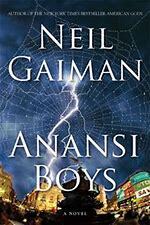 Photo Credit:https://tinyurl.com/y8xp7o74
Photo Credit:https://tinyurl.com/y8xp7o74 Anansi Boys is a fantasy novel by Neil Gaiman.
According to Wikipedia, in the novel, “Mr. Nancy” — an incarnation of our West African trickster god Anansi — dies, leaving two sons, who in turn discover each other. The novel follows their adventures as they explore their common heritage.
Although it is not a sequel to Gaiman’s previous novel American Gods, the character of Mr. Nancy appears in both books.
The spider outsmarts the sky gods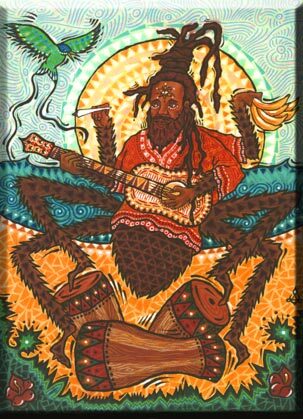 Photo Credit: https://tinyurl.com/yy9bob58
Photo Credit: https://tinyurl.com/yy9bob58Anansi and the Sky Kingdom is a folk tale that explains why we have light here on earth. It is a wonderful story and I am posting the video below. Kids will especially love the story and if you want to read it, it can be read for free, here.
If you find this article fun and interesting and you decide to expand on this story, using the Anansi in your work- let me know about it in the comment section below, and as usual…happy writing!
 This is a West African Folk tale of how the gods gave the gift of light to the earth.
This is a West African Folk tale of how the gods gave the gift of light to the earth.
The ‘Aztec Death Whistle,’ artifact of religion or of psychological warfare?
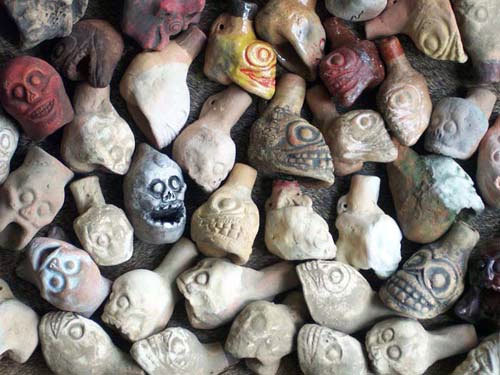 Photo Credit: https://tinyurl.com/y6ovs6as
Photo Credit: https://tinyurl.com/y6ovs6asThe Aztec death whistle was most likely used as a spiritual conduit of sorts during religious practices and was also used (it’s widely believed) as a form of psychological warfare. It was probably used to terrify Aztec and pre-Columbian foes on the battle field.
The German Music Archeologist, Arnd Adje Both is credited as the man who first blew on the artifact in the 90’s. The video above is what made the whistle part of the mainstream consciousness.
This ‘whistle’ however, belongs to the mysteries of the Aztecs and other Mezo-American cultures, because truth be told, we don’t know much about it.
Where was it discovered?The whistle was first discovered in the 90’s by modern archeologists, within the crossed arms of a man sacrificed to the Aztec god of the wind, Ehecatl.
The remains were laid ceremoniously in front of the temple of Ehecatl in Tlatelolco. The death ‘whistle,’ discovered was dual sided, and had death represented on one side and wind represented on the other.
The artifact is referenced by Salvador Guilliem Arroyo in 1999, and is the only ancient death whistle to be documented within an archaeological context. This leaves the subject of the Tlapitzcalzin (death whistle) open to debate. It raises more questions than we have answers. Let’s start with a bit of who’s who in the Aztec world and how they were associated.
 Remains and dual sided whistle found at Tlatelolco Photo credit: https://tinyurl.com/y6xlgsjb
Remains and dual sided whistle found at Tlatelolco Photo credit: https://tinyurl.com/y6xlgsjb According to Wikipedia, In Aztec mythology, Ehecatl (“wind”) was just one aspect of the god Quetzalcoatl. His name in the Nahuatl language means “feathered serpent” or “Quetzal-feathered Serpent”. The earliest known documentation of the worship of a Feathered Serpent occurs in Teotihuacan in Mexico, within the Late Preclassic to Early Classic period (400 BC – 600 AD.) Veneration of the god appears to have spread throughout Mesoamerica by the Late Classic period (600–900 AD). Quetzacoatl, according to thoughtco, was a creator god, also associated with the planet Venus. Quetzalcoatl was the patron god of the arts and of knowledge. He was one of the most human-loving of the gods in the Aztec pantheon. He was the god who met with an ant to provide humans with their first maize to plant, and he was responsible for saving all humanity at the beginning of the Fifth Sun.
 Quetzalcoatl Ehecatl Photo Credit: https://tinyurl.com/y5h4zy9f
Quetzalcoatl Ehecatl Photo Credit: https://tinyurl.com/y5h4zy9f The pre-Columbian people believed that the god’s breath (Ehecatl) moved the sun and pushed away rain. Other times they wanted rain and would sacrifice to Tlaloc to summon this rain god’s favor.
Legend says that Ehecatl (wind) fell in love with a human girl named Mayahuel, and gave mankind the ability to love so that she could return his passion.
But the Aztecs believed in death (sacrifice,) so that the humans could preserve the relationship with the gods and ensure that life as they knew it, would keep on going. The sun (god Huitzilopochtli) would rise another day.
Not an actual, ‘whistle’The death whistles themselves, according to Roberto Velázquez Cabrera, the founder of the Mexico City-based Instituto Virtual de Investigación Tlapitzcalzin (death whistle), the extraordinary ‘death whistle’ wasn’t a whistle at all.
It was exclusively used in several zones of ancient Mexico and belongs to a very unusual family of Mexican resonators that are not well known and which can produce special sounds imitating animal calls or the noise of the wind or storms.
Roberto Velázquez Cabrera
*It is therefore not a common whistle nor a musical instrument. We will use the term throughout, however for the sake of continuity.
‘Wind and Death’ were known ‘associates’Roberto Velázquez Cabrera also suggests in his writings on the subject, which can be found here, that the death whistles in addition to Ehecatl, were associated with (death) or the death god Mictlantecutli, which is why a skull or owl (death totem) would have been used symbolically, but the whistle made the sound of the wind. Death and wind were associated with each other (Borgia Codex snippet pictured below.)
 Wind and Death Back to Back – Borgia Codex Photo Credit: https://tinyurl.com/y2pve4cd
Wind and Death Back to Back – Borgia Codex Photo Credit: https://tinyurl.com/y2pve4cd The only other reference to the possible ancient use of this type of whistle comes in the form of a literary reference rather than archeological. In the book, ‘Myths of Mexico and Peru,’ by Lewis Spence you can find the following text:
“The most remarkable festival in connection with Tezcatlipoca was the Toxcatl, held in the fifth month. On the day of this festival a youth was slain who for an entire year previously had been carefully instructed in the role of victim… He assumed the name, garb, and attributes of Tezcatlipoca himself… [as] the earthly representative of the deity…. He carried also the whistle symbolical of the deity [as Lord of the Night Wind], and made with it a noise such as the weird wind of night makes when it hurries through the streets.” (Lewis Spence, Myths of Mexico and Peru, London, 1913, pp. 69-70).
Playing in harmonyAccording to Roberto Velázquez Cabrera, more research needs to be done on the effects of the death whistle sound especially when more than one are played in unison.
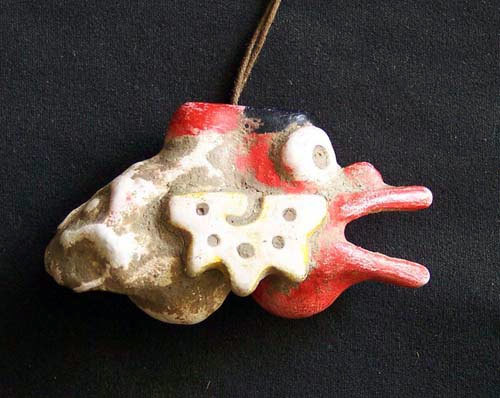 Dual sided Death Whistle Photo Credit: https://tinyurl.com/yyt2jex4
Dual sided Death Whistle Photo Credit: https://tinyurl.com/yyt2jex4“For example, we know that when two or more similar ancient whistles or their models are played at the same time, special effects can be produced, due to the vibrations generated or ‘phantom’ sounds. If the beats are ‘infrasonic’ (too low for the human ear to detect) they may alter states of consciousness. Several death whistles played at the same time can generate very complex vibrations, because their noisy signals are produced in a range of frequencies and the effects on humans is significant due to the intensity and range of their main frequencies, but their effects on health have not yet been analyzed formally. An experimental dual model of the death whistle with the faces of Ehecatl and Mictlantecutli has already been used to test the possibility of the two whistles found at Tlatelolco being played at the same time. The sounds generated are similar to those of a storm. The produced frequencies are more complex and of greater intensity than those of single whistle models.”
Psychological warfare or healing?The death whistles are widely thought to be examples of psychological warfare used by the Aztecs. Imagine hundreds or thousands of these resonators being used at once to strike fear in the hearts and minds of your enemy.
The whistles could have also been used for healing?? The video above talks more about these subjects. What about you? What do you think the whistles were used for? Let us know in the comments below and as usual, happy writing!
August 30, 2021
The Easter Sleuth- A Short Story for KIDS
 Photo Credit: https://tinyurl.com/yydwvb2n
Photo Credit: https://tinyurl.com/yydwvb2nThe Easter season began and Grandmama was selling off our belongings. Our sleepy Iowa town sold corn and gossip by the bushel but didn’t have a lot of room for old jazz musicians like Grandmama was. It was the 1950’s.
We were the talk of the town, and not in a good way since our parents died in a violent, submerging car crash. Grandmama moved in to “help.” She was my mama’s mama and she was an emotionally cruel woman who resented being anything but stylish, talented and pampered. “I used to play to full crowds.” She would say and she could see them there in front of her…her adoring fans. When she came back to reality, all she would see was us. The dishtowel over her shoulder seemed to remind her that she was a domestic caretaker now and she’d crack it in the air like a whip when she saw us. Her brown eyes turning black with disgust.
Then she’d day something fresh like, “What are you kids still doing here,” and she would say it with a cruel chuckle. “Quit acting like you are a spy, Johnny. You’re not 007, you’re nothing but a nuisance. I’m too young to be taking care of kids again.” Grandmama adjusted her finger waves with long manicured fingers in the mirror.
She could be a professional piano player in town instead of volunteering at church like she did sometimes. Maybe she was scared she wasn’t good enough, we didn’t know. She also could teach piano lessons or something instead of selling our parents’ things for money. She had options, but she didn’t like any of them.
Grandmama could play that piano and make it sing! But it didn’t bring her an ounce of joy, and so it didn’t bring anybody else any joy neither. There was a dullness in her movements. There was nothing but coldness in the places where love should have been.
“I know you took mama’s broaches. I followed you to the pawn shop.” I said to her boldly one morning. She stared at me long and hard, but she didn’t do anything.
 Photo Credit: https://tinyurl.com/y3y3s239
Photo Credit: https://tinyurl.com/y3y3s239“You look just like my husband who went missin’ after he went off to the war in 1942. Anyone ever tell you that, Johnny? Your granddaddy was the love of my life, but he went off and ain’t nobody ever seen him since.” She jazzed the piano keys a little and took a swig of her sugary coffee, slamming down mama’s good china. Then she inspected it closely as if she had over looked its value, and looked at me… irreverently slamming down the piano lid.
“I know he’s still alive too…I can feel it inmy bones. Clean this mess up.” Grandmama said as she sauntered away from the oakbreakfast table. She was wearing my mother’s favorite dress. The beautiful onewith the embroidered red roses. I couldn’t help it, I could excuse everythingelse, but the dress? It made my blood boil. The next morning, I found it rolledup at the bottom of grandmama’s hamper and I took it in to be cleaned andpressed. I then took it to the charity where my mother used to volunteer. Theycollected beautiful clothes for women who needed a second chance in life. Shewould have wanted them to have it.
“You are a sweet boy, Johnny.” The charity lady said. “Your mother was very proud of you and I know she would have been very happy you did this…I know just the lady it will fit too.” I walked home happily. Smelling the flowers and noticing the leaves blowing on the trees. I took a breath of the fresh Iowa air and I felt mama. She was all around me, hugging me through the wind. I cried a little bit, but no one saw me.
 Photo Credit: https://tinyurl.com/y3zurz3e
Photo Credit: https://tinyurl.com/y3zurz3eI was only 12 years old the year my parents died and when the magic started. I had this incredible chance encounter with the Hare-man, at Easter, at the height of my sadness. At that time, I thought it all a coincidence, but now I’m not so sure.
I was up late reading by flashlight, and I saw the enormous creature speed through a freestanding portal out in the field. It was Easter’s Eve and suddenly his motorcycle skidded wildly, sending loose dirt raining down my window. It scared me.
I panicked and peeked…intrigued to see a steam powered motorcycle parked. The larger than life creature, a tall dapper Rabbit adjusted his spectacles and waistcoat. He whispered something inaudible.
Fairies brought three, beautiful baskets, through an opening they made in the side of our little blue house. Our place immediately filled with the scent of sage and citrus and was infused with an overwhelming sense of joy. I noticed the feeling right away because the atmosphere was suddenly light and buoyant and took the place of a heavy, melancholy sadness. Flowers started growing in my room. Vines twirled out of the walls and gorgeous blooms busted through, sending plaster and white paint flying everywhere.
 Photo Credit: https://tinyurl.com/y53wss3e
Photo Credit: https://tinyurl.com/y53wss3eThe creature was a bunny on top but had human legs. I became petrified at the impossibility of it all and dropped the flashlight. It rolled the length of the floor, stopping with a thud at the wall. I sensed him pressing his ear to the house, and I pressed my ear too and heard him breathing. It wasn’t the sound of a docile bunny and my knobby knees knocked together in fear.
“Bunny?” I said through the wall.
“Johnny, take care of your sister and your Grandmotherand find Lenny…” I heard him say.
“Who is Lenny?” I asked the void. The creaturewasn’t standing there anymore.
His name was the Hazamann. My father explained to me when I was small. His name meant “Hare-man in German. He’s what most people call the Easter Bunny.” My father knew this because the whole notion of the creature came from Germany to Pennsylvania with Immigrants in the 1700’s and my father himself was a white German Immigrant.
I couldn’t believe what I was hearing out there. The huge rabbit beast was retreating, the entire encounter lasted three minutes tops, but it changed my life forever. The vines, flowers and foliage withdrew into the walls and were gone, like nothing had even happened. Some of the peace stayed though, which is a mystery to me.
 Photo Credit: https://tinyurl.com/y3l835fq
Photo Credit: https://tinyurl.com/y3l835fqMy mama had been the real magic in my life when I was a boy. I remember her reading methe James Bond novel, CASINO ROYALE the year she died, it was 1953.
I adored mama. She smelled like home, like baby powder and Oxydol soap and was loving and kind. We were all alone without her, my sister Hattie and me. That old red covered bridge just couldn’t carry the weight of them and fell, cascading the black car, our loving parents, our family puppy “Night time,” and the romantic picnic down into the raging waters below.
“Johnny!” Hattie yelled. She must have heard the Hazamann’s motorcycletoo. We never woke up on Easter’s eve.I wondered if he revved the engine on purpose to wake us up as he rode backthrough the portal door.
“Shhhh, you’re going to wake Grandmama upwith your carrying on.” I said to Hattie. She came to my side of the room. We pressedour ears to the wall in unison. “See, I think he’s leaving.”
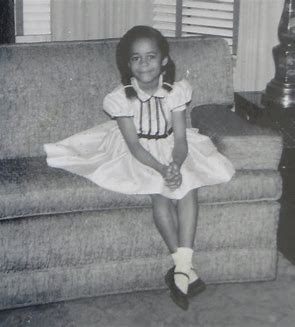 Photo Credit: https://tinyurl.com/y3wpchxo
Photo Credit: https://tinyurl.com/y3wpchxo“I’m scared.” Hattie said. She was only 6, so I didn’t make her feel bad for being a scaredy-cat. “It’s ok, I’ll protect you, I’m 007, remember, just like mama used to say?” It calmed her.
“I wish Mama could see this.” Hattie said to me as we watched the portal disappear into thin air. A few magical sparkles were all that were left, and she smiled from ear to ear with excitement.
By the next Easter, LIVE AND LET DIE, the nextin the Bond series had been released and a copy was in my Easter basket. Thepages smelled so crisp and new. I received spy accessories to accompany my bookand Hattie got a new puppy.
“I’ll name him ‘Night’ since he’s black as my other doggie used to be…he’s a German Shepherd Johnny. He can help us find your bad guys! Things are going to get much better now, I just know it.”
 Photo Credit: https://tinyurl.com/y26prpbh
Photo Credit: https://tinyurl.com/y26prpbh“I think so too.” I said, wiping my eyes. “What else did you get?” Both of us stopped as Hattie lifted it up. A new bottle of mama’s perfume. Hattie sprayed it into the air, and we took it in hungrily. Nostalgia and love poured into us from our eager little noses to our dancing, happy feet. Grandmama watched us and smiled with a lost sense of joy. She recognized the smell too and she started to cry.
“Look kids, I know I haven’t been the best Grandmamato you, but I am going to try. I bet you didn’t know that your Grandmama couldcook?”
“I thought all you knew how to do was eat.”Hattie said since she had been the one making all the sandwiches since mama hadgone.
“Well, I suppose I deserve that. Today is as good a day as any to show you how it’s really done. They don’t need me at church till 2pm.” She said and she started to cook. It was Easter and she was really getting into the spirit of it. She cooked and cooked and cooked. The house was filled with sweet and savory smells and there was music playing and laughter in the air and then suddenly a knock at the door.
Grandmama answered it.
“Rose.” An older man standing at the door saidand took his hat off, lowering his eyes.
“Lenny, is that you?” Grandmama dropped thekitchen towel she was holding and ran up to the man. He dropped his hat andthey embraced.
“…But I haven’t seen you in 10 years. I wasafraid that you were killed in battle…or worse, ran off and found you another woman.”
“Johnny found me, Rose…for the life of me, Idon’t know how, but he did and now here I am.” Lenny smiled. I didn’t think youwanted me…you were a big jazz star and I was nothin’ but a soldier, too proudto come on back home after the war ended.”
“Did you do this Johnny?” Grandmama said.
“Yes, it wasn’t as hard to find him as Ithought. You can find just about anything at the library. Mama taught me that.”I said.
 Photo Credit: https://tinyurl.com/y2qadllk
Photo Credit: https://tinyurl.com/y2qadllk“She was always a smart one, my Imogene.” Lenny said, hanging his head again. He started to cry, great big crocodile tears. Maybe because he was so glad to be found. Maybe because his baby girl had died. I wasn’t sure, but there was love in our house again that morning. We sang and we ate, and we accompanied our grandparents to church where Lenny was welcomed with hardy slaps on the back by familiar faces. Grandmama was on the piano. Honestly, I didn’t know what awakening happiness looked like…but I saw it that day. She had come back from the dead that morning. She had a twinkle in her eye. Joy poured from her fingers and we all felt it.
January 10, 2021
Mythological Creature; the Apsara, a Hindu and Buddhist fairy of the clouds, with writing prompt
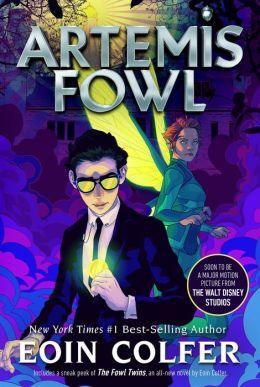 Photo Credit: https://tinyurl.com/y2vcmlzr
Photo Credit: https://tinyurl.com/y2vcmlzrFairies, angels, sprites and pixies have long been written about in myth and folklore. They come to our realm and indulge in all of the human vices that seem to contradict the very essence of who we think they are. In the children’s book series Artemis Fowl, by Eoin Colfer, there’s a fairy who lives in Ho Chi Mihn City and has been drunk for hundreds of years. In the story, she will only be persuaded to give young Artemis information about ‘the book’ in exchange for booze. By the end of their exchange, Artemis has given the ancient being an elixir to detox her. This fairy could easily be an Apsara, though he doesn’t say so. According to Indianetzone, Apsaras in Indian Mythology were the court dancers of the king of Gods, and of thunder, Lord Indra. It is Lord Indra, who directs the Apsaras to seduce mortals, kings and sages, who became powerful enough to threaten the mighty Indra. Apsaras are said to be celestial maidens of exquisite beauty and alluring charm and artistically blessed with the power of dancing and singing. They are also said to be shapeshifters.
Origin of Apsaras
Sage Kashyapa, had many wives. He is considered the father of many celestial races. The demi-gods are born from his wife Aditi and demons come from his other wife Diti. In other ancient legends, it is said that the Apsaras came out of the churning of the sea and are sometimes considered sirens.
 Photo Credit; Gandharvas https://tinyurl.com/y6akgt6e
Photo Credit; Gandharvas https://tinyurl.com/y6akgt6eAccording to Wikipedia, in Hinduism, the Gandharvas are male nature spirits, husbands of the Apsaras. Some are part animal, usually a bird or horse. They have superb musical skills. They guard the Soma and make beautiful music for the gods in their palaces. In Vedic tradition, soma is a ritual drink of importance among the early Indians. Gandharvas are frequently depicted as singers in the court of the gods. Gandharvas act as messengers between the gods and humans. In Hindu law, a gandharva marriage is one contracted by mutual consent and without formal rituals.
 Photo Credit: https://tinyurl.com/yyn5rxol
Photo Credit: https://tinyurl.com/yyn5rxolAccording to Encyclopedia Britannica, the asparas, originally water nymphs, provided sensual pleasure for both gods and men. They have been beautifully depicted in sculpture and painting in India and throughout areas of South and Southeast Asia influenced by Hinduism and Buddhism. Notable examples are the 5th–6th-century frescoes at Ajanta in India and at Sigiriya in Sri Lanka and the sculptures and bas-reliefs decorating the temples of Angkor, Cambodia.
Wikipedia states there are two types of apsaras; laukika (worldly), of whom thirty-four are specified, and daivika (divine), of which there are ten. Urvasi, Menaka, Rambha, Tilottama and Ghritachi are the most famous among them.
English translations of the word “apsara” include “nymph“, “fairy“, “celestial nymph”, and “celestial maiden”.
As ethereal beings who inhabit the skies, and are often depicted as taking flight, or at service of a god. They may be compared to angels.
 Photo Credit: Dancers – https://tinyurl.com/y3jty7wa
Photo Credit: Dancers – https://tinyurl.com/y3jty7waApsaras are said to be able to change their shape at will, and rule over the fortunes of gaming and gambling. Apsaras are sometimes compared to the muses of ancient Greece, with each of the 26 Apsaras at Indra’s court representing a distinct and differing aspect of the performing arts. They are also associated with fertility rites.
Writing Prompt
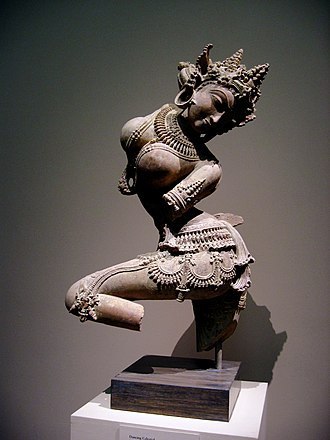 Photo Credit: https://tinyurl.com/y42fdl86
Photo Credit: https://tinyurl.com/y42fdl86The thing that sticks out to me about the Apsaras is that they apparently were around during the primordial age with the god Indra. According to hindutsav.com Indra is the God of thunder, lightning, storms, rains, and river flows. Lord Indra is also the God of War, the greatest of all warriors, and the strongest of all beings. Indra is like Zeus as far as his mighty power goes.
The apsara were important beings since they were in his company and are considered to be like angels – OK, so this is very interesting….
For the writing prompt I would like to play around with the idea that an Apsara comes to earth like John Travolta’s 1996 movie ‘Micheal.’
According to IMDB here is the movie synopsis- Frank Quinlan and Huey Driscoll, two reporters from a Chicago-based tabloid, along with Dorothy Winters, an ‘angel expert’, are asked to travel to rural Iowa to investigate a claim from an old woman that claims she shares her house with a real, life archangel named Michael.
 Photo Credit: https://tinyurl.com/y3pls8fy
Photo Credit: https://tinyurl.com/y3pls8fyUpon arrival, they see that her claims are true – but Michael is not what they expected: he smokes, drinks beer, has a very active libido and has a rather colourful vocabulary. In fact, they would never believe he was an arch angel, were it not for the two feathery wings protruding from his back. Michael agrees to travel to Chicago with the threesome, but what they don’t realise is that the journey they are about to undertake will change their lives forever.
Our writing prompt is similar, but it is an Apsara woman who takes center stage. What does she look like. Does she have a family? This woman is surprisingly an angel. She drinks and smokes. I would like to offer that she is from Cambodia and like John Travolta’s character, the only thing angelic about her are the two feathery wings that protrude from her back.
 Photo Credit: https://tinyurl.com/y66u5bnk
Photo Credit: https://tinyurl.com/y66u5bnkYou encounter her one night in an alley. She has been beaten up badly and you stop to help her. She tells you that she needs to go to New York city to see her brother. He is dying and needs her help. You take her, but what happens along the way…the healings, the insights, the visions. There are transformations of almost everyone and everything she encounters…including you and it’s more than you bargained for. What happens??
If you find this article fun and interesting and you decide to expand on this story-let me know how this story continues in the comment section below, and as usual…happy writing!
December 13, 2020
Creature Concept Design for Writers- Comparing the process of developing concept art and writing believable Sci-Fi characters
 Photo Credit: https://tinyurl.com/y2cptxun
Photo Credit: https://tinyurl.com/y2cptxunI am a big fan of the Syfy channel’s show FACEOFF, and it got me thinking about the specifics of brainstorming the characters for the show and how creating and 3D design relates to our craft and the creative business of being writers. We too must master the art of creature concept design on paper. In an interview with Jerad S. Marantz on gnomon.edu -Jerad shares 10 important things you need to know to become a concept designer. I am sharing this truncated version of the interview because I see definite similarities in the process of creating believable fantasy and science fiction characters.
1. Creature design starts with real animals
A well-designed creature, no matter how unearthly, draws inspiration from its earthly counterparts. “Creature design is the combination of familiar elements,” argues Jerad. “You’d think you could do almost anything, but if you do, the creature isn’t relatable.”
 Photo Credit: https://tinyurl.com/y3cysmg7
Photo Credit: https://tinyurl.com/y3cysmg7This problem — unless the viewer has a familiar point of reference for the creature, they have no way of deciding whether it is ‘realistic’ — this is most acute in visual effects. “When the creature is on screen, it will be interacting with actors, so if it isn’t designed well, it’s going to look like Who Framed Roger Rabbit?” Jerad says. “Unless you create something unique in an educated way, that shows your understanding of anatomy, of gravity, of all these other factors, [it won’t hold up].” This is relatable to writing too. Research of the folklore behind a given creature is extremely important. If you are designing a creature from scratch, it must be relatable to the reader. Making it have recognizable traits is imperative to bring the reader in and to keep them reading and engaged.
But if a creature designer is restricted to forms that appear in the real world, they can at least be creative about the way in which they combine them. Good creature designs often take familiar sources and blend them in less familiar ways. Jerad’s own concept for the Pouncer from Microsoft Studios’ Gears of War 4 draws on a most unlikely menagerie of creatures, including scorpions, crabs and pit bull dogs.
2. A lot of the time, you’re working blind
“This industry is actually a lot less organized than people assume,” says Jerad. “One of the misconceptions about working in film or TV is that the script is done and you’re just coming in and illustrating concepts that are already well-described.”
Instead, creature designers are usually brought in during the script-development phase of a movie, and may be hired to clarify not only the look of a creature but its role in the story. With the script consisting of little more than a treatment, the description of the creature itself is often similarly brief, and open-ended.
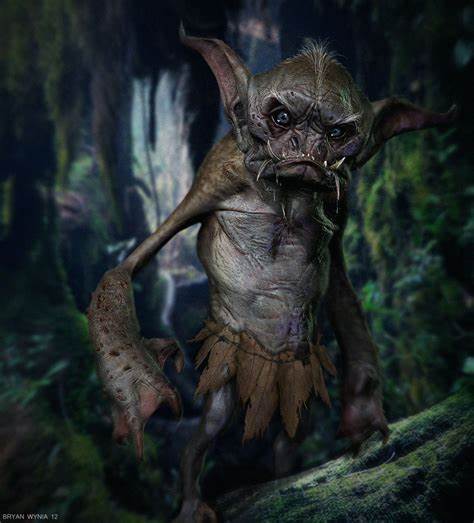 Photo Credit: General Creature Concept Design – https://tinyurl.com/y57zh5s9
Photo Credit: General Creature Concept Design – https://tinyurl.com/y57zh5s9“I typically get a sentence of description — they want a ‘vampire-werewolf thing’ — and then I start work,” says Jerad.
3. You need to learn to interpret briefs
But even the shortest brief can contain a surprising amount of information, if you only know how to decode it. For the Alien Rock Grubber, a creature design tutorial he recorded for The Gnomon Workshop in 2014, Jerad set himself the fictitious, but typical, brief: ‘The Alien Rock Grubber scavenges for eggs along the jagged terrain.’
“Writers use specific words for a reason, so it becomes the job of the concept artist to dissect the description,” says Jerad. “There’s actually a ton of information in that sentence: he’s alien, there are rocks involved somehow, he’s scavenging — now why use the word scavenge instead of forage? — for eggs. [To us], that’s kind of creepy: he’s scavenging to eat unborn beings. And if he’s navigating through jagged terrain, he’s got to be nimble. All these elements in one sentence inform the design.”
**I would argue that it also informs the senses of your readers. Developing solid, interesting, believable creatures is key to moving your story forward.
4. Reference is everything
The first step of any creature design project is to collect suitable reference material. “I cannot stress the importance of reference enough,” says Jerad. “The number one mistake that artists — even seasoned professionals — make is jumping straight into an assignment and inventing. Memory is just not that good. I’ve been studying anatomy for 20 years and I still have charts all over my office.”
 Photo Credit: https://tinyurl.com/yx9bnkrv
Photo Credit: https://tinyurl.com/yx9bnkrvBefore beginning work on a creature, Jerad creates a collage of “every animal that could be referenced” in the design, combining online image searches and material from reference books like Eliot Goldfinger’s Animal Anatomy for Artists. The one thing that he doesn’t include is other artists’ designs.
“I always include real photos and anatomical reference, but I try not to look at concept art because I don’t want to take on another artist’s filter,” he says.
(This is different for writers. The greats insist that it is extremely important to read, read, read works in your genre to know not only what is selling currently but to also absorb what constitutes good work in your genre. You should read widely outside of your genre too. )
Jerad often incorporates clothing, props or people into his reference sheets. “I incorporate people into the collage because I want the audience to have a definite emotional relationship with the creature,” he reveals.
5. Traditional art still rules…
Although the entertainment industry now works digitally, Jerad still advises young artists to begin their training away from the screen, building up traditional art skills before trying to build up software skills.
“Draw every day. (Writers…write everyday) Draw on paper: have sketchpads accessible to you at all times,” he says. “Take painting classes before you start messing with Photoshop. You can learn a 3D program in a month or two, but you could spend 10 years learning to draw well.”
6. Good design means getting bad ideas out early
 Photo Credit: https://tinyurl.com/yyfp82hl
Photo Credit: https://tinyurl.com/yyfp82hlThis is true for writing too.
Early in the creature design process, Jerad aims to generate five to ten rough sketches a day to send to the client for feedback. The goal at this stage is less to find design elements that work than to rule out ones that don’t. (As writers we do this process alone in drafting and then in revisions and then again with beta readers.)
“Concept art is a funneling [process]. Most of the time, you’re showing clients stuff that isn’t right,” he says. “A design that is completely wrong can be more helpful than one where there’s something there. Once you do something that is completely wrong, you can put all of those shapes aside and not use them again.”
Back in the day, I would buy these beautiful pristine sketchbooks but it felt like every time I opened the page I had to draw a masterpiece, and that isn’t concept art. Being crude, being fast, you can get a lot of your ideas out very quickly.”
The same is true for writing.
7. You won’t have total creative control
While concept art is a creative discipline, you must face the fact that you will be working to someone else’s brief. “Creative freedom is a bit of an illusion,” says Jerad. “As a concept artist, you are being hired to present your solution for what a character should look like, but once you present that solution, you will get notes [for changes].” You can expect this on your road to publication as well.
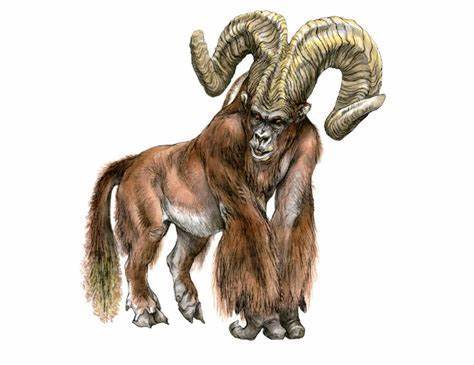 Photo Credit:
Photo Credit: This can be a hard lesson to learn. “The reason that people become concept artists is that they believe that their sense of design is good,” Jerad points out. “To spend that much time improving your craft, you have to genuinely believe your ideas are solid. It’s only through the process of working on shows that you discover your place.”
Although you will eventually get to the point where people are asking your opinion, the process takes time. “Creative freedom comes with your relationship with a client, and you have to earn that relationship,” says Jerad. “A lot of people make the mistake of thinking that because they’ve gone through school and have a great portfolio, they’re going to be asked to design stuff [right away], and it doesn’t work like that.” Absolutely, this is true with writing too.
10. Just ‘good’ isn’t good enough any more
While demand for concept art has increased hugely since the turn of the millennium, so has the number of aspiring concept artists. “For anyone wanting to become a concept artist, good isn’t good enough,” says Jerad. “There are tons of ‘good’ out there. No matter how great an artist you are, it would be foolish to feel irreplaceable.”
To stand out from the crowd, you need to be both good and unusual – and for that, you need to be prepared to do your research in unexpected places. “Try to find references that haven’t been used before,” advises Jerad. “There are still quite a few of them – it doesn’t just have to be animals. There are all types of weird plant life.”
 Photo Credit: https://tinyurl.com/yxc5lwjx
Photo Credit: https://tinyurl.com/yxc5lwjxAbove all, draw your inspiration from nature, not from gallery websites. “So many artists are now only influenced by other artists, whereas in the past, you had more original voices,” says Jerad. “Everyone starts out as a fan, but if you want originality, or the illusion of originality, put down the concept art books and draw from life.”
If you find this article fun and interesting, let me know in the comment section below, and as usual…happy writing!
December 10, 2020
Mythological Creature; The Anakim, giants from the land of Canaan with writing prompt
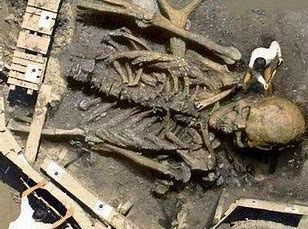 Photo Credit: https://tinyurl.com/y589nen7
Photo Credit: https://tinyurl.com/y589nen7According to Earth-History.com The Anakim lived before the great flood and Noah’s ark. The flood was apparently deliberate to clean the earth of these unholy creatures. Many say these beings were well documented and really lived. I’m here to talk about these creatures from a folkloric standpoint. If you believe they were real or if you believe this is heresy- in either case, this may not be the post for you. We are working up to a writing prompt here and this creature could be a great source of inspiration for your writing.
Before the Anakim, came the Nephilim. Before the Nephilim came the fallen angels. Before the fallen angles, came the Angels and Arch Angels. Some call them demons, fallen angels, or aliens. They use these words to describe what the Anakim were. Either way, they were gigantic folkloric creatures. Humanoid, but I’ve seen them with horns, looking more like demons. Once you know about them you can let your imagination go wild with what they looked like.
 Photo Credit: https://tinyurl.com/yxdlxl3v
Photo Credit: https://tinyurl.com/yxdlxl3vEarth-History.com describes these giants this way; After their descent to Earth, the Watchers (Fallen Angles from the book of Enoch. ((Fun fact: Enoch was the Great Grandfather of Noah)) the Watchers indulged in earthly delights with their chosen human ‘wives.’ Through these unions were born giant offspring named Nephilim, a Hebrew word meaning those who have fallen, which rendered in Greek translations as Gigantes, or ‘Giants’. The Anakim then, are the children of the Nephilim.
Gary Lite explains how pervasive and widely accepted this concept was and is.
That from the stories of the Nephilim in the bible, to the Greek Olympian Gods and Titans of Greek mythology, to the fallen Angels, known as the Watchers in the Book of Enoch, to the Annunaki from the ancient Sumerians, to the Hindu Vedas, Norse mythology, and Roman mythology…” – these creatures are reinforced and referenced over and over.
The legends of the gods, angels, demons, giants, hero’s, and flood deluges are very common from this time period across the globe.
According to Gary Lite, Many scholars make the parallel connection between the Greek Gods or Olympians, being Nephilim and the fallen angels, being their parents, or the Titans, of the Genesis story.
 Photo Credit: https://tinyurl.com/y253k94e
Photo Credit: https://tinyurl.com/y253k94eThe flood of the Bible and the Greek flood myths are remarkably similar.
Gary Lite asks the question; Is it possible that the Greek myths are not myths? Was Zeus a Nephilim? Was his father (Cronus) a fallen angel referred to within a group of fallen angles called the “sons of God” in Genesis 6?
 Photo Credit: https://tinyurl.com/y3udlqza
Photo Credit: https://tinyurl.com/y3udlqzaAccording to Wikipedia, Anakim, not to beat a dead horse, but they were described as a race of giants, descended from Anak, according to the Hebrew Tanakh. They were said to have lived in the southern part of the land of Canaan, near Hebron (Gen. 23:2; Josh. 15:13). According to Genesis 14:5-6 they inhabited the region later known as Edom and Moab in the days of Abraham.
 Photo Credit: David and Goliath https://tinyurl.com/yxjr6w5x
Photo Credit: David and Goliath https://tinyurl.com/yxjr6w5xTheir formidable appearance, as described by the Twelve Spies sent to search the land, filled the Israelites with terror. The Israelites seem to have identified them with the Nephilim, the giants (Genesis 6:4, Numbers 13:33) of the antediluvian age. Joshua finally expelled them from the land, except for some who found a refuge in the Philistine cities of Gaza, Gath, and Ashdod (Joshua 11:22), thus the Philistine giant (Goliath) whom David encountered (2 Samuel 21:15-22 ) was a descendant of the Anakim.
Writing Prompt
 Photo Credit: https://tinyurl.com/lnbcmac
Photo Credit: https://tinyurl.com/lnbcmacAnakim are the kids of the Nephilim. Ok, so let’s put these creatures in a modern context. Everyone wants to be noticed and to have a platform today. What if your were 36 ft tall? I don’t mean to say that there is something wrong in this scenario with being that tall. I mean it is ‘accepted.’ However, there would likely be segregation. There would likely be separate, bigger, shopping places and then that separateness would slowly breed contempt. There would be Anakim leaders and homo sapien leaders around the world. There would be mixed race couples. This writing prompt is…that you are an Anakim leader in Europe or the United States. You sense the current political, racial, social and financial climate. Do you have super powers like the Greek Olympians? Do you use your powers for good or for nefarious purposes. Let’s face it. We all have power within us…how do you choose to use it?
If you find this article fun and interesting and you decide to expand on this story-let me know how this story continues in the comment section below, and as usual…happy writing!
December 8, 2020
Mythological Creature; Antaeus, giant from Greek Mythology *lived* in Libya- with writing prompt
According to Wikipedia, Greeks of the 6th century BC, who had established colonies along the coast of North Africa, placed Antaeus in the interior desert of Libya.
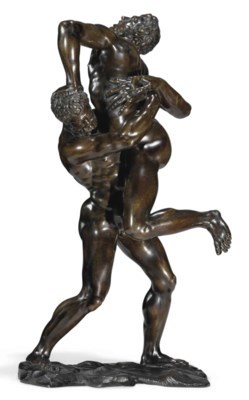 Photo Credit: https://tinyurl.com/y5u3luue
Photo Credit: https://tinyurl.com/y5u3luueWhen the Roman commander Quintus Sertorius crossed from Hispania to North Africa, he was told by the residents of Tingis (Tangier), far to the west of Libya, that the gigantic remains of Antaeus could be found within a certain tumulus; or mounded grave. Digging it open, his men found giant bones; closing the site. Sertorius made offerings and “helped to magnify the tomb’s reputation.”
According to Wikipedia Antaeus means “Opponent”, derived from ἀντάω, antao, ( meaning; I face, I oppose.) His wife was the goddess Tinge, and he had a daughter named Alceis or Barce.
The Ancient Myth
According to Thoughtco.com, Antaeus was the son of Gaia and Poseidon. His strength appeared to be invincible. Antaeus challenged all passers-by to a wrestling match which he invariably won. Upon winning, he always slaughtered his adversaries.
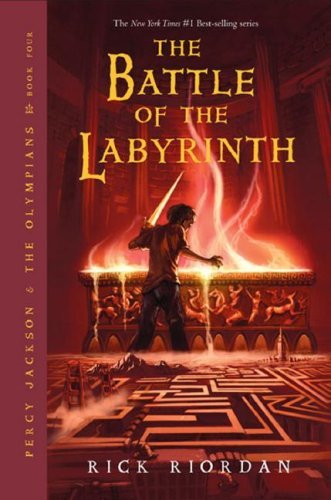 Photo Credit: https://tinyurl.com/y28u2lu8
Photo Credit: https://tinyurl.com/y28u2lu8That is until he met Hercules.
Hercules had gone to the garden of the Hesperides for an apple. (The Hesperides, daughters of Night or the Titan Atlas, took care of the garden.) On Hercules’ way back, the giant challenged the hero to his customary wrestling match. Hercules was having trouble at first. No matter how many times Hercules threw Antaeus off and tossed him to the ground, it did no good. If anything, the giant appeared rejuvenated from the encounter.
Hercules eventually realized that Gaia, (the Earth)- Antaeus’ mother, was the source of Antaeus’ strength, so Hercules held the giant up until all his power drained away. Antaeus’s secret was that if he stayed firmly on the ground…and in contact with his mother…he could not be beaten. After Hercules killed Antaeus, by keeping him off the ground, he then crushed him with a bear hug.
 Photo Credit: Antaeus from the Disney Animated Film, Hercules https://tinyurl.com/yxsf4x7f
Photo Credit: Antaeus from the Disney Animated Film, Hercules https://tinyurl.com/yxsf4x7fWikipedia explains that Hercules is a Roman hero and god. He was the Roman equivalent of the Greek divine hero Heracles, who was the son of Zeus (Roman equivalent Jupiter) and the mortal Alcmene. In classical mythology, Hercules is famous for his strength and for his numerous far-ranging adventures.
The Romans adapted the Greek hero’s iconography and myths for their literature and art under the name Hercules. In later Western art and literature and in popular culture, Hercules is more commonly used than Heracles as the name of the hero. Hercules was a multifaceted figure with contradictory characteristics, which enabled later artists and writers to pick and choose how to represent him.
Ancient and Modern Pop Culture References
Some ancient writers who mention Antaeus in their writings are Pindar, Apollodorus, and Quintus and Smyrnus. The contest between Heracles and Antaeus was a favored subject in ancient and Renaissance sculpture.
 Photo Credit: https://tinyurl.com/yxlecuow
Photo Credit: https://tinyurl.com/yxlecuowIncidentally, the modern American hero and demigod, also a descendant of Poseidon, Percy Jackson, (b)y Rick Riordan, also defeats Antaeus by suspending him above the earth.
Other pop culture references are movies Hercules Unchained (1958) and Hercules the Avenger (1965) as well as the Disney’s Animated film, Hercules (1997).
Chanel has a fragrance for men called Antaeus (1981) and there is a French black metal band with the same name.
Writing Prompt *A Modern Twist on the Ancient Myth
 Photo Credit: https://tinyurl.com/yxnwlw7z
Photo Credit: https://tinyurl.com/yxnwlw7zYou are a modern incarnation of Gaia, mother of Antaeus.
Stressed from work, and while driving to pick up a delicious lunch in Tripoli, you accidentally bump into the car in front of you. It’s just a light fender bender, but it pops open the other car’s trunk.
You notice that the driver is none other than Hercules—and there’s a dead body in his trunk. The body is of Antaeus your son and you notice this right off the bat because his body barely fits into the trunk. What elaborate excuse does Hercules give you to explain his alarming cargo? Where was he taking the body? What do you do? Why are they reincarnated? Are they doomed to replay the same scenario again and again for all eternity? How can they break the cycle?
If you find this article fun and interesting and you decide to expand on this story, let me know how it continues in the comment section below, and as usual…happy writing!
December 3, 2020
The Hope Goblin- a short story for KIDS #bullying #selfconfidence
 Balthazar Souse
Balthazar Souse Photo by Pixabay on Pexels.com
 Harry Winston
Harry WinstonPhoto Credit: https://tinyurl.com/y6gcqh3y
 Historic Images of the Smithsonian;
Historic Images of the Smithsonian;Mrs. Edna Winston presenting the Hope Diamond to Secretary Leonard Carmichael and George Switzer, November 10, 1958.
My name is Balthazar Souse.
I’m the friend of Harry Winston and spouse.
I’ve a prominent and successful auction house,
right behind the Opera in DC.
This is the story of an artifact-I had, whose goblin indweller was evil, and bad.
I’d give anything to reverse this tale, but what’s done is done and you’re well aware, that the moral of this story is worth it’s wares.
*
Do you know about us?
Come and visit, you must.
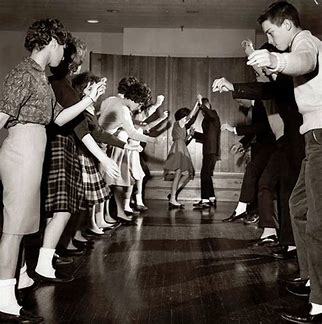 Balthazar Souse Dancing Event Photo Credit: https://tinyurl.com/y5o3ngvb
Balthazar Souse Dancing Event Photo Credit: https://tinyurl.com/y5o3ngvbThere are so many things to do. We have a fair to attract- the ones who believe in magic and there is no doubt that person, is you.
*
The contents of this story struck, when I least expected the truck that drove up to the house that day.
*
It delivered a trunk,
*
once owned by a wealthy and powerful king,
and he used it to hold his priceless ruby ring;
until the ring went mis-sing by the goblin,
one medieval spring,
and the King was found dead in the woods with…nothing.
*
 Photo Credit: https://tinyurl.com/yxd2lnyl
Photo Credit: https://tinyurl.com/yxd2lnylIt was a sweltering day in August,
when an unlucky family came in hoggish,
and were demanding that I sell, and that they buy.
Strange they were so urgent,
but I couldn’t pass up payment,
and so they took it, with-out even a goodbye.
 Photo Credit: https://tinyurl.com/yxo4qhuc
Photo Credit: https://tinyurl.com/yxo4qhuc Photo by Viktor Smith on Pexels.com
Photo by Viktor Smith on Pexels.comThe musical prodigy, Isabelle received the surprise gift that day (at our fair,) but it seemed to her there, that she was just a square, in the midst of the popular children.
*
In her hands she held the trunk,
it was her birthday after all; her heart sunk,
when she realized that her friends didn’t know.
With her long braided hair, she sat in her chair,
and was wheeled around by a boy named Joe.
 Photo by Patrick De Boeck on Pexels.com
Photo by Patrick De Boeck on Pexels.com*
There is an old saying that isn’t quite nice,
that goblins are stingy, and will trade for a price.
They want baubles and trinkets and beads galore,
but there is one thing that they want even more.
They want the allegiance, of a person in the house,
who’s as quiet and kind as the mousiest, mouse.
“Cinnamon spice, say everything thrice,”
-The Hope Goblin
says a goblin to someone who won’t budge.
They are teasing and nasty,
with fits that are ghastly,
and many give in to their nudge.
 Photo Credit: https://tinyurl.com/y4cusste
Photo Credit: https://tinyurl.com/y4cussteIsabelle, in the house with the old Banyan,
had the temperament of a warm companion,
so was fully the opposite of that bully,
and he taunted her to no end.
This went on for months and months,
and her stomach was in knots,
and she felt so alone and neglected.
*
With her parents too busy,
to help with poor Izzy,
she was left quite alone, unprotected.
*
At school Izzy heard from the teacher,
that being more assertive and confident was a feature,
that would get you ahead in a world without space- for a kind hearted temperament, she was in this place.
 Photo Credit: https://tinyurl.com/yxfvufmw
Photo Credit: https://tinyurl.com/yxfvufmwOne day the goblin, up to his old tricks,
sat in the den and had taken therein,
Isabelle’s violin for no good reason again,
it was simply to stir her up, she understood.
*
Isabelle was fed up,
and so she read up;
and she prepared her plan against him good.
*
Special attention was given to the history of the goblin.
Since he was dangerous and would never leave,
it was important to believe,
In the research about the thief,
who had come from across the seas.
It had said in the books,
that in order to hook, the goblin, you must flip his decree.
I can do this thought Isabelle inside of herself.
For she wasn’t as quiet as the mousiest mouse.
“Won’t you give me, please goblin, the instrument you’ve stolen,
for its the music that I love so pure.”
But the goblin wouldn’t offer the instrument she was after,
and dug in his heels even more.
“Cinnamon spice, say everything thrice.” said the goblin so cunning, so sure.
“I’ve asked you three times, and I’ve begged you before,
 Photo Credit: https://tinyurl.com/yxvpalfb
Photo Credit: https://tinyurl.com/yxvpalfbbut you know the violin is the thing I adore.
Give it now..
can’t you see…
you’ve no power, over me.
I’ll send you packing, on the count, of, three.
“…one.., two, three!”
The goblin was stunned and filled with dismay,
for as long as he’d lived, he’d not been treated this way.
“I’ll count to three…twice more.”
repeated Izzy to he.
“One.., two, three!”
And then again,
“One…, two…” she paused for enjoyment, she had never felt so empowered.
“three!” she loudly exclaimed,
to the vanishing coward.
Isabelle smiled and she beamed with pride,
As her low self esteem,
now, bloomed open- wide.
*
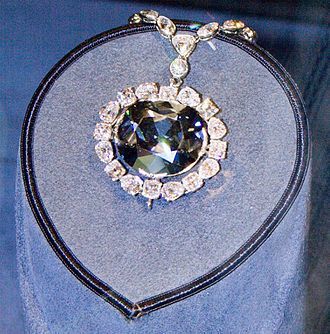 Harry Winston’s Hope Diamond Photo Credit: https://tinyurl.com/yasv9b2w
Harry Winston’s Hope Diamond Photo Credit: https://tinyurl.com/yasv9b2wThe huge diamond sat in the trunk shining bright,
and Isabelle saw it,
and gasped with great fright.
“Where did he get this?” She held the diamond up. (She remembered seeing it at the fair.)
*
It was as big as her fist,
nearly filled up the trunk!
It shone in the light,
now filling with delight,
and she set it down gently,
“What a beautiful sight!”
It took one call,
yes, that was all,
for Isabelle to be regarded as a hero, that fall.
Never before,
had standing up to a bully,
been so well paid,
nor in such a hurry.
People clapped and they cheered and they shouted “Hooray,”
at the public event, where she was celebrated that day.
She was given the reward
and she thought about it hard,
and decided to give back in some way.
*
For paying it forward and giving,
is what made her happiest anyway!
*
Isabelle, in a gown…
started a music and arts center in town,
for the disabled, the elusive, and the reclusive.
With her parents’ new attention,
she was able to focus their intention
on the Public Relations side, of this new convention!

Most bullies can dish out what they can’t take.
If you have a bully;
…be strong and stand up for yourself, in your space.
Be assertive but kind and just carve out your place.
For the world needs more YOU,
to be taught about grace.
If you find this article fun, interesting and informative, let me know in the comment section below, and as usual…happy writing!



